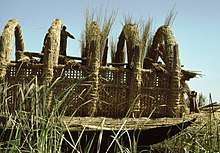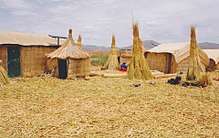Reed (plant)
Reed is a common name for several tall, grass-like plants of wetlands.
Varieties
They are all members of the order Poales (in the modern, expanded circumscription), and include:
- In the Poaceae (grass) family
- Common reed (Phragmites australis (Cav.) Trin. ex Steud.), the original species named reed
- Giant reed (Arundo donax L.), used for making reeds for musical instruments
- Burma reed (Neyraudia reynaudiana)
- Reed canary-grass (Phalaris arundinacea)
- Reed sweet-grass (Glyceria maxima)
- Small-reed (Calamagrostis species)
- In the Cyperaceae (sedge) family
- Paper reed or papyrus (Cyperus papyrus), the source of the Ancient Egyptian writing material, also used for making boats
- In the Typhaceae family
- Bur-reed (Sparganium species)
- Reed-mace (Typha species), also called bulrush or cattail
- In the Restionaceae family
- Cape thatching reed (Elegia tectorum), a restio originating from the South-western Cape, South Africa.
- Thatching reed (Thamnochortus insignis), another restio species originating from the same geographic region.
Use in construction

A reed house under construction in the marshes of Iraq, 1978

Reed houses being built on a reed island in Lake Titicaca
Many cultures have used reeds in construction of buildings of various types.
Use in thatching
A man in Germany thatching a roof using reeds
Phragmites australis, the common reed, is used in many areas for thatching roofs. In the United Kingdom, common reed used for this purpose is known as "Norfolk reed" or "water reed". However, "wheat reed" and "Devon reed" are not in fact reed at all, but long-stemmed wheat straw.
Other uses
Bamboo and, even more commonly, rattan stems are used as "reed sticks" to wick and disperse the scent of essential oils in aroma diffusers. (See Rattan#Food source and medicinal potential.)
See also
External links
| Wikisource has the text of the 1911 Encyclopædia Britannica article Reed. |
This article is issued from
Wikipedia.
The text is licensed under Creative Commons - Attribution - Sharealike.
Additional terms may apply for the media files.
